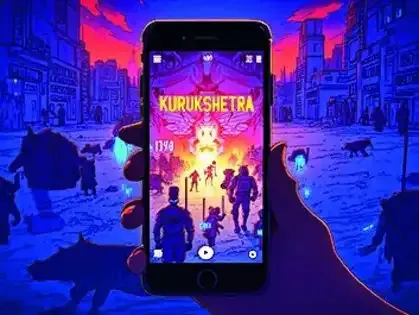In an age where cultural stories travel globally at the speed of light, it remains astonishing that the vast tapestry of Indian itihasa - often dismissed in the West as mythology - is yet to have its own AAA - high- budget, high-profile games developed by large studios or publishers - gaming blockbuster. This absence, however, also represents a monumental opportunity.
Globally, the gaming industry, valued at over $250 bn, and, in particular, the action-adventure genre, thrives on compelling narratives and immersive worlds. Titles like God of War, inspired by Greek and Norse epics, and Black Myth: Wukong, rooted in China's Journey to the West, highlight universal appeal and immense commercial potential of folklore-rich narratives. Yet, India's ancient epics, rich with profound storytelling and nuanced characters, remain largely untapped in AAA gaming landscape.
Itihasa, comprising the Ramayana and Mahabharata, along with the intricate cosmology of Shiva and Vishnu, provides narratives brimming with dramatic depth, moral complexities and philosophical richness - ideally suited for immersive gaming and universal appeal.
Unlike myths from other cultures, these narratives have traditionally been presented not just as stories but as recorded histories (itihasa), with layers of philosophy embedded in cultural and social fabric of Indian civilisation.
Why, then, has Indian itihasa remained unexplored on global entertainment platforms like gaming? The answer, in part, lies in India's colonial past. Colonial rule significantly disrupted indigenous storytelling, sidelining local narratives in favour of Western literary and cultural traditions. The Western approach tended to look down upon indigenous cultures. Consequently, India's ancient epics, despite their timeless appeal and universal themes, remained largely confined to local indigenous traditions or simplified adaptations, preventing their true global recognition and appreciation.
Our traditional storytelling must evolve and reclaim its rightful space in the world. There was a time when our stories impacted many abroad - traces of which are still visible in Southeast Asia. While modern Indian literature and cinema have a strong domestic following, their global reach has been limited to those interested in India and our diaspora. A true mass mainstream crossover, like what has happened with Korean stories, is yet to happen.
AAA gaming offers a dynamic, participatory immersion unlike any other medium - perfectly suited to bring depth and complexity of Indian itihasa to a global audience and the youth.
However, creating AAA gaming experiences demands more than compelling narratives. It also requires technical excellence and global production standards. Cultural legitimacy is also indispensable.
The moment is ripe. Gaming today is more than entertainment - it is mainstream culture, profoundly shaping global narratives. India's gaming market is rapidly expanding, with one of the largest youth populations in the world, uniquely positioned to create and consume this content.
Furthermore, gaming represents a potent form of cultural soft power. Countries like Japan and South Korea have successfully exported their cultures globally through gaming, shaping perceptions and fostering international cultural dialogue. India's rich narratives provide a similar opportunity to establish its cultural influence globally, fostering deeper understanding and appreciation.
It's not just about entertainment, but a deeper engagement with India's consciousness through compelling interactive experiences.
The writer is an author and co-founder, Tara Gaming Ltd.
Globally, the gaming industry, valued at over $250 bn, and, in particular, the action-adventure genre, thrives on compelling narratives and immersive worlds. Titles like God of War, inspired by Greek and Norse epics, and Black Myth: Wukong, rooted in China's Journey to the West, highlight universal appeal and immense commercial potential of folklore-rich narratives. Yet, India's ancient epics, rich with profound storytelling and nuanced characters, remain largely untapped in AAA gaming landscape.
Itihasa, comprising the Ramayana and Mahabharata, along with the intricate cosmology of Shiva and Vishnu, provides narratives brimming with dramatic depth, moral complexities and philosophical richness - ideally suited for immersive gaming and universal appeal.
Unlike myths from other cultures, these narratives have traditionally been presented not just as stories but as recorded histories (itihasa), with layers of philosophy embedded in cultural and social fabric of Indian civilisation.
Why, then, has Indian itihasa remained unexplored on global entertainment platforms like gaming? The answer, in part, lies in India's colonial past. Colonial rule significantly disrupted indigenous storytelling, sidelining local narratives in favour of Western literary and cultural traditions. The Western approach tended to look down upon indigenous cultures. Consequently, India's ancient epics, despite their timeless appeal and universal themes, remained largely confined to local indigenous traditions or simplified adaptations, preventing their true global recognition and appreciation.
Our traditional storytelling must evolve and reclaim its rightful space in the world. There was a time when our stories impacted many abroad - traces of which are still visible in Southeast Asia. While modern Indian literature and cinema have a strong domestic following, their global reach has been limited to those interested in India and our diaspora. A true mass mainstream crossover, like what has happened with Korean stories, is yet to happen.
AAA gaming offers a dynamic, participatory immersion unlike any other medium - perfectly suited to bring depth and complexity of Indian itihasa to a global audience and the youth.
However, creating AAA gaming experiences demands more than compelling narratives. It also requires technical excellence and global production standards. Cultural legitimacy is also indispensable.
The moment is ripe. Gaming today is more than entertainment - it is mainstream culture, profoundly shaping global narratives. India's gaming market is rapidly expanding, with one of the largest youth populations in the world, uniquely positioned to create and consume this content.
Furthermore, gaming represents a potent form of cultural soft power. Countries like Japan and South Korea have successfully exported their cultures globally through gaming, shaping perceptions and fostering international cultural dialogue. India's rich narratives provide a similar opportunity to establish its cultural influence globally, fostering deeper understanding and appreciation.
It's not just about entertainment, but a deeper engagement with India's consciousness through compelling interactive experiences.
The writer is an author and co-founder, Tara Gaming Ltd.
(Disclaimer: The opinions expressed in this column are that of the writer. The facts and opinions expressed here do not reflect the views of www.economictimes.com.)






Amish Tripathi
Amish Tripathi is an author and co-founder, Tara Gaming Ltd